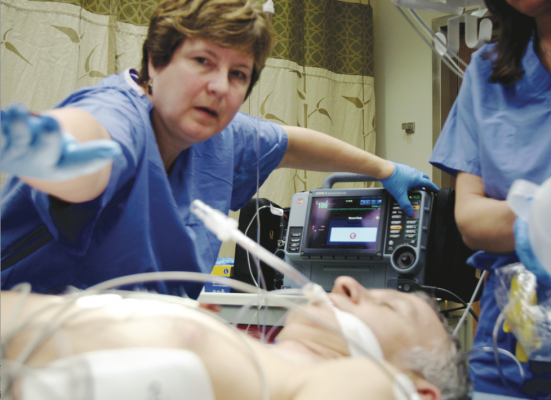
September 2, 2015 — Emergency department patients with chest pain suggestive of acute myocardial infarction (AMI) can be triaged more quickly and safely using a new rapid assay with refined cut-offs, German research suggests.
The Biomarkers in Acute Cardiovascular Care (BACC) study, presented as a Hot Line at the European Society of Cardiology (ESC) Congress 2015, suggests this new algorithm can reduce mortality and cut triage times to one hour, compared to the standard three-hour approach.
“There is an urgent need for fast decision-making for this growing patient population,” said principal investigator of the study Dirk Westermann, M.D., Ph.D., from the University Heart Centre Hamburg and the German Centre for Cardiovascular Research.
“Use of this algorithm in patients with suspected AMI allows for highly accurate and rapid rule-out as well as rule-in, enabling safe discharge or rapid treatment initiation. This rapid algorithm might be applicable to clinical practice without a loss of diagnostic safety.”
For patients with suspected AMI, current guidelines recommend analyzing cardiac troponin I – a marker of myocyte (cardiac muscle cell) necrosis - directly at admission and then three hours later, to determine if the level warrants admission or discharge.
This means patients must remain in the hospital for at least three hours before receiving a diagnosis, using resources that are increasingly scarce.
In addition, troponin I levels are currently considered abnormal if they are above the 99th percentile from a healthy reference population - in this case 27 ng/L, said Westermann.
But new, highly sensitive troponin I assays can give results more quickly and detect more subtle troponin I elevations that may be important for assessing cardiovascular risk, he explained.
The BACC study included 1,045 patients (mean age 65 years) with acute chest pain suggestive of AMI presenting at the emergency room of the university hospital in Eppendorf, Hamburg, Germany. Patients were assessed using both the standard three-hour assay as well as a highly sensitive one-hour one.
Based on the standard approach, 184 patients were diagnosed with AMI and kept in the hospital, while the rest were discharged home. All patients were then followed for six months.
Comparing the results of both assays in the cohort, the researchers calculated the best troponin I cut-off value to rule out AMI was 6 ng/L – “far lower than the currently recommended 27 ng/L,” noted Westermann.
They then tested the clinical relevance of this new cut-off for predicting cardiovascular events using data from the BiomarCaRE study — one of the largest studies to include troponin I measurement in more than 75,000 individuals from the general population.
The BiomarCaRE data confirmed that when individuals from the general population had troponin I values higher than 6 ng/L, they were at increased risk of death or cardiovascular disease, whereas patients with levels below this cut-off could be safely discharged home.
“This documents that even slightly elevated troponin I values are important predictors of cardiovascular disease,” said Westermann. “At the same time, utilizing a very low cut-off for discharge of patients with suggestive AMI is safe, since these patients are at the lowest possible risk for future events.”
The researchers then applied the new cut-offs to the BAAC cohort and found that mortality would have been lower if patients had been triaged with the new algorithm compared to the routine three-hour approach.
“The standard approach underestimated risk for many patients and resulted in high mortality,” said Westermann. “In addition, using the rapid, sensitive assay would have reduced usage of the emergency room and scarce medical resources, enabling a faster diagnosis and better treatment.”
The algorithm had negative predictive values of 99.7 percent after one hour and 100 percent after three hours.
“Therefore, our algorithm identified all patients at risk, but was not unnecessarily unspecific,” said Westermann.
“This suggests that using more sensitive cut-offs than suggested by the guidelines can improve the safety for patients discharged home.”
The algorithm was then validated in two independent cohorts (ADAPT and APACE trials) that included 4,009 patients with acute chest pain suggestive of AMI.
For more information: www.escardio.org


 November 14, 2025
November 14, 2025 









